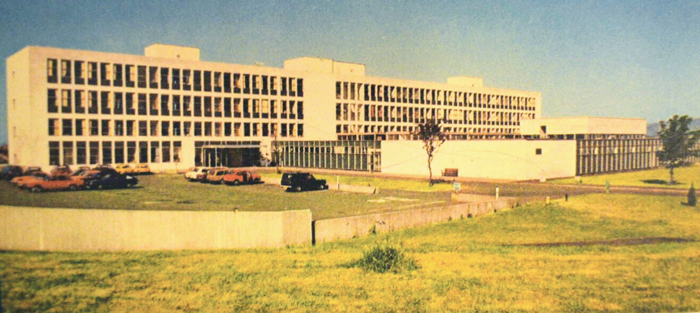Past and present colleagues and friends recently celebrated 50 years of the Canniesburn Plastic Surgery Unit, with scientific meetings held at The Royal College of Physicians and Surgeons in Glasgow. Friendships were renewed and memories of being part of the ‘Canniesburn Family’ were shared in evening social events, while keynote speakers from the UK and abroad gave inspiring lectures. It was certainly an occasion to celebrate the many advances in plastic surgery over the past 50 years.
The West of Scotland Plastic Surgery and Jaw Unit, opened in 1940 in Ballochmyle Hospital, an Emergency Medical Services (EMS) hospital built to treat the expected casualties following the outbreak of war in 1939. Initially, the unit was staffed by general surgeons who had trained with the eminent Plastic Surgeon Sir Harold Gillies. Gillies made frequent visits to EMS hospitals throughout the United Kingdom, offering help, guidance and training. In 1943, Mr Jack Tough, a General Surgeon who had trained in plastic surgery, was appointed as Surgeon in Charge of the Regional Plastic Surgery Unit.
Plastic surgery developed out of the mutilations of war and the techniques in reconstructive surgery became applicable not only to these casualties, but to the whole population. Reconstructive plastic surgery therefore expanded to deal with congenital deformities, burns and trauma, degenerative diseases, cancer excision and reconstruction. Beds were made available in Seafield Children’s Hospital in Ayr, for the treatment of congenital and childhood problems.

Glasgow Royal Infirmary was one of the first hospitals in the United Kingdom to develop a separate Burns Unit in 1873. It was run by general surgeons until the 1940s, when Leonard Colebrook, an eminent Bacteriologist was appointed Director of the Medical Research Council’s Burns Unit in Glasgow’s Royal Infirmary. The unit became part of the plastic surgery service until 1944 when, following administrative difficulties with providing suitable treatment conditions, Colebrook moved the Burns Unit to Birmingham Accident Hospital in 1944. Throughout this period Jack Tough continued to attract eminent staff to help develop plastic surgery. Tom Gibson joined in 1948. Previously he had served a whole time appointment with the MRC Burns Unit in Glasgow Royal Infirmary and was the first man to recognise rejection of skin grafts, known as ‘the second set phenomenon’. This work was to open the doors for our understanding of rejection and for tissue transplantation. Sir Peter Medawar had been brought to the MRC Burns Unit in Glasgow Royal Infirmary to work with Gibson and Medawar went on to develop his ideas in tissue transplantation and was subsequently knighted and awarded a Nobel Prize.
As plastic surgery developed, so its facilities expanded. In addition to Ballochmyle Hospital, Seafield Children’s Hospital and the Burns Unit in Glasgow Royal Infirmary, the service had beds in the Western Infirmary and at Phillipshill Hospital which housed the Spinal Injuries Unit. The main adult centre in Ballochmyle was rather isolated and away from the centre of the population. In 1961, plans were drawn up for a new Plastic Surgery Unit of 138 beds and associated facilities to be built at Canniesburn. Glasgow Royal Infirmary already had convalescent and private beds in the grounds of Canniesburn. Jack Tough was to prove the driving force for the development of Canniesburn Hospital as a Plastic Surgery Unit. This was to be the largest specialised unit in plastic surgery in all of Europe and was built at a cost of £996,000. It started admitting patients in September 1967. It was to become the hub of the West of Scotland Regional service and all major plastic surgery for the West of Scotland was therefore centralised into Canniesburn.
The sheer volume of cases, together with the consultant expertise, rapidly gave Canniesburn an international reputation as a centre of excellence. It attracted visitors and trainees from all over the world and developed international teaching and training courses which continue to the present day. With Canniesburn at the centre, peripheral facilities were required to service the population for the West of Scotland. Outreach facilities, particularly for clinics and day-case operating were developed in many of the district general hospitals that were being set up in the neighbouring health boards. The major elective cases were still undertaken at the hub in Canniesburn but trauma and emergencies were done at a wide variety of differing hospitals.
There developed a need to centralise trauma services in plastic surgery and so in the early 1990s, a new Burns and Trauma Unit was opened in wards 23 and 24 in Glasgow Royal Infirmary and the old Burns Unit vacated. With the increasing complexity of plastic surgery and its involvement in major deformity and cancer work, there was a need to move Canniesburn to a major hospital which could accommodate both the elective and emergency work load of plastic surgery.
A new Canniesburn Plastic Surgery Unit was built within the Jubilee Building at Glasgow Royal Infirmary bringing together both elective and emergency plastic surgery for the first time. Such is the international reputation of Canniesburn as a centre for plastic surgery, the name has been retained. The new home of the Canniesburn Plastic Surgery Unit is modern and offers all the advantages of a major teaching hospital. This together with the dedicated staff will ensure the continuing high reputation of the Unit.
CONTACT
Dorothy Stobie
dorothy.stobie@ggc.scot.nhs.uk
www.canniesburn.org
COMMENTS ARE WELCOME




